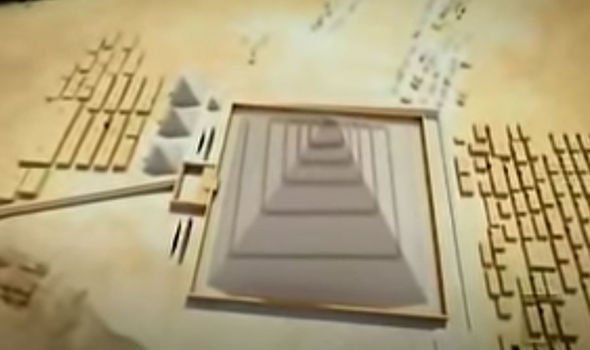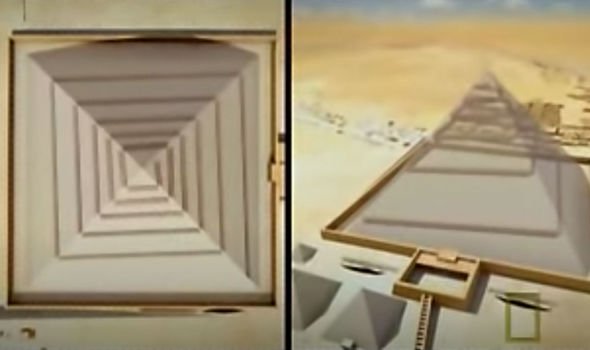‘Incredible’ find made INSIDE Great Pyramid after 4,500 years

‘Incredible’ find made INSIDE Great Pyramid after 4,500 years
The Great Pyramid at Giza is the oldest and largest of the three ancient monuments of the plateau of Giza and is believed to have been constructed over 20 years period for pharaoh Khufu, even though his body has never been recovered.
This is also the only one largely intact of the Seven Wonders of the ancient world, and is estimated to weigh approximately 6 million tonnes, from the 2.3 million blocks of limestone and granite used, some of which weigh up to 80 tonnes. For years, many have argued over how this colossal monument could have been built with the tools and equipment available during the Fourth Dynasty.

But surprisingly National Geographic showed how the French architect Jean-Pierre Houdin may have cracked the secret of the ancient Egyptian in their ‘Great Pyramid Mystery Solved’ series. The 2008 series revealed: “Jean-Pierre approached the mystery of the Great Pyramid with an architect’s eye.
“Working from the most detailed architectural plans ever drawn of the Great Pyramid slowly his theory began to evolve. “As the years passed, unnoticed by Egyptologists, he came to know the minute details of the pyramid like no one else on Earth.
“The question is, how do you raise blocks all the way to the top of a 480-foot pyramid? “We saw that there were real problems with either a single ramp, or a spiral ramp, and lifting cranes certainly don’t do the job.”
The series went on to reveal how the answer may have been hiding inside the walls of the Great Pyramid all along. The narrator explained: “His solution still has a ramp, but it’s inside the pyramid and, incredibly, according to Jean-Pierre, it’s been hidden there for 4,500 years.

“He calculated that the slope of this ramp had to be about seven percent so the men could haul the blocks up it. “He also figured the ramp would have to start at the base of the pyramid and go upwards as the pyramid grew. “But remember, the pyramid is not solid, inside are three large chambers, the lowest is called the Queen’s Chamber and above it is a mysterious room called the Grand Gallery and on top is the King’s burial chamber.
“All three chambers are connected by passageways, but is it possible to have a ramp snaking up through the pyramid that doesn’t run into one of these chambers or passageways?” The series went on to detail some of the problems that Mr Houdin faced in trying to prove his hypothesis.

The narrator added: “As he began building his computer model, he could see the ramp just 10 feet inside the smooth outer surface of the pyramid, turning level after level – all the way to the top. “Amazingly, the ramp never hit any of the chambers or passageways inside the Great Pyramid and for the first time in history, a structural 3D model had been built to test it.
“But how did they turn the blocks around the corners? His solution was that they left the corners open and at the end of each ramp, a notch – about 30 feet square – would have been left open.
“It let in light and fresh air, but there would also be a crane so it could travel up the next flight of ramp – these cranes could be the machines that Herodotus was talking about.”
Mr Houdin’s theory would hit a wall for more than 15 years until remarkable images captured by a scan of the pyramid revealed what could be the final proof. The series continued: “If he is right about the internal ramp, the French team should have detected it in the 1980 hi-tech survey, but in their published report, there is no diagram of an internal ramp.

“It looks like he is wrong, surely a study this sophisticated would have found evidence of something as large as an internal ramp? “But 15 years after, Jean-Pierre was asked to meet a member of the French team who said he had some very good news for him.
“He had heard about Jean-Pierre’s theory and wanted to show him something – a diagram that the French did not fully understand, so they never published it.
“The computer printout shows a low-density spiral shape inside the Great Pyramid and it’s amazingly close to Jean-Pierre’s drawing of the internal ramp.”
In 2006 Mr Houdin announced his discovery in his book ‘Khufu: The Secrets Behind the Building of the Great Pyramid,’ and in 2008 he and Egyptologist Bob Brier wrote a second one: ’The Secret of the Great Pyramid.’ But, not everyone is so convinced.
Mr Houdin’s thesis remains unproven and in 2007, UCL Egyptologist David Jeffreys described the internal spiral hypothesis as “far-fetched and horribly complicated”.
Oxford University’s John Baines also declared that he was “suspicious of any theory that seeks to explain only how the Great Pyramid was built”.